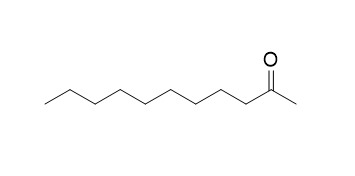Methyl nonyl ketone
Methyl nonyl ketone could as in-soil odour repellent, it has the potential to repel common voles in the field.
Inquire / Order:
manager@chemfaces.com
Technical Inquiries:
service@chemfaces.com
Tel:
+86-27-84237783
Fax:
+86-27-84254680
Address:
1 Building, No. 83, CheCheng Rd., Wuhan Economic and Technological Development Zone, Wuhan, Hubei 430056, PRC
Providing storage is as stated on the product vial and the vial is kept tightly sealed, the product can be stored for up to
24 months(2-8C).
Wherever possible, you should prepare and use solutions on the same day. However, if you need to make up stock solutions in advance, we recommend that you store the solution as aliquots in tightly sealed vials at -20C. Generally, these will be useable for up to two weeks. Before use, and prior to opening the vial we recommend that you allow your product to equilibrate to room temperature for at least 1 hour.
Need more advice on solubility, usage and handling? Please email to: service@chemfaces.com
The packaging of the product may have turned upside down during transportation, resulting in the natural compounds adhering to the neck or cap of the vial. take the vial out of its packaging and gently shake to let the compounds fall to the bottom of the vial. for liquid products, centrifuge at 200-500 RPM to gather the liquid at the bottom of the vial. try to avoid loss or contamination during handling.
Int J Mol Sci.2021, 22(21):11447.
Front Pharmacol.2020, 11:251.
The Japan Society for Analytical Chemistry2017, 613-617
Food Engineering Progress2019, 23(3)209-216
Journal of Functional Foods2017, 30:30-38
Chemistry of Plant Raw Materials2022, 20220210569.
Hanoi University of Pharmacy2023, 14(1):30-39.
Plant Foods Hum Nutr.2021, 76(4):472-477.
ACS Omega.2022, 7(44):40009-40020.
Phytomedicine.2022, 96:153877.
Related and Featured Products
Journal of Chinese Medicinal Materials, 2007, 30(12):1558-1560.
Tissue distribution on methyl nonyl ketone of the volatile oil from Houttyunia cordata in mice.[Pubmed:
18422191]
To study the tissue distribution on Methyl nonyl ketone of the volatile oil from Houttuynia cordata in mice in order to provide a guidance for the clinical trial.
METHODS AND RESULTS:
The concentrations of the volatile oil from Houttuynia cordata in biological samples were determined by GC method.Results:After a single oral dose of 5.0 g/kg volatile oil from Houttuynia cordata in mice, parent drug was mainly distributed in windpipe,intesting,liver,kidney,heart, blood,spleen,lung,brain,muscle;after 7 hours,parent drug of every tissue decreased over 90%.
CONCLUSIONS:
Parent drug mianly distributes in windpipe,intestine,liver,kidney.The experiment provides pharmacokinetic evidence for the rational administration and the further development of Houttuynia cordata.
Pest Management ence, 2013 Mar;69(3):431-6.
Efficacy of methyl nonyl ketone as an in-soil repellent for common voles (Microtus arvalis).[Pubmed:
23292923]
Common voles (Microtus arvalis) can cause enormous damage in agriculture. Tests were conducted using an alternative approach to rodenticide-based vole management by developing an in-soil odour repellent based on the secondary plant metabolite Methyl nonyl ketone (MNK).
METHODS AND RESULTS:
Replicated 25 m(2) plots were established in forage grassland to test efficacy and application schemes using a foam application that included MNK. MNK significantly reduced the number of reopened burrow entrances in all field trials compared with untreated control plots, with repeated application for 6 days reducing vole activity by up to 90%. The addition of black pepper oil (BPO) did not enhance the efficacy of the MNK foam. Voles tended to avoid burrows where MNK was applied and rather opened new burrows instead of reopening the treated burrow entrances. The foam application scheme led to a repellent effect that lasted for about 4-5 days. A single additional application of MNK after 4 days can extend the treatment effects for a further 2 days.
CONCLUSIONS:
The results indicate that MNK has the potential to repel common voles in the field. However, more studies are needed to enhance the duration of a one-off treatment effect to yield a user-friendly field application to manage vole populations.



